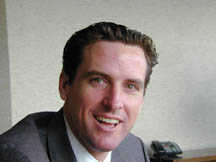Bay
Crossings Interview
Gavin in Love
Gavin Newsom, on the eve of his
pre-wedding honeymoon, talks about his love for San
Franciscoís waterfront (but not Fishermenís Wharf), regionalism and
the environment
 |
| Newsom
supports discussions about regional control of seaports and
airports. "I think it is critical". |
Fair to say that you love Fishermanís
Wharf?
I love the waterfront, but I donít love
Fishermenís Wharf. I remember walking down here with my grandfather
when it was a working wharf. Now it has become primarily tourist based
and we are losing the working waterfront. I was concerned enough about
it that I put a ballot initiative in Novemberís ballot here in San
Francisco against the prospect of taking another one of our piers, Pier
45, and turning it into a theme park. The point is weíve got a lot of
work to do down at the waterfront to return it to what it was and to
allow more than just tourists to enjoy this magnificent and spectacular
area of the world.
| |
| "I
love the waterfront, but I donít love Fishermenís
Wharf." |
You are a hot political item and a hot
political item like you must have a schedule thatís a nightmare. Why
did you agree to join the WTA?
I guess because as a fourth generation
Bay Area resident, I feel an obligation to the region. I think WTA is
going to be fruitful and long lasting. Itís embarked on a dialogue
that confounds all 9 Bay Area counties, and that is how do we deal with
a growing population that has provided us this economic benefit but also
such great transportation concerns? We simply have to reduce use of the
automobile.
Many people are queasy about filling in
two square miles of San Francisco Bay to expand the San Francisco
Airport, and they worry that not enough consideration has been given to
making the best possible use of the regionís other airports, like
Oakland International. Wouldnít a regional approach to governing the
areaís seaports and airports make sense, on the model of the Port
Authority in New York?
At first blush, I think the answer is
"yes", and regardless of what happens at the airport, I think
there are going to be some lessons about regional process and dialogue,
and Iíd expand that beyond Oakland, San Jose and San Francisco
airports. At the hearings weíve held thereís consensus on that
point, not only from environmentalists but the business community as
well. Obviously where thereís not consensus is on whether or not we go
forward with Bay fill. But utilizing technologies, maximizing
efficiencies as it relates to cargo as well as passenger traffic by
organizing in a way thatís more efficient with the airports working in
common, I think is only appropriate. Of course, it is difficult. The
primary focus of the San Francisco International Airport is the San
Francisco International Airport. The primary focus of Oakland Airport is
Oakland Airport and ditto San Jose. So the challenge is to organize a
dialogue thatís constructive and not just a surface dialogue that
doesnít produce any results. And right now I suggest that we havenít
engaged in very constructive or fruitful dialogue, itís more just been
along the lines of trying to assuage the concerns of environmentalists.
But clearly with regional transportation issues like ferry service,
regionalism is critical..
So whatever happens with airport
expansion, you would encourage discussion of a regional approach to
governing the seaports and the airports?
Indeed, I think it is critical. The fact
that we have gone our separate ways has produced an untenable result.
Continue to do what youíve done, youíll get what youíve got. Itís
time for an order of magnitude change. I mean you look at any MTC study,
any of these studies, and you do the modeling out 20-25 years, what they
show is that we are going to stifle ability for this region to prosper
in the long run unless we change the way we do business and the order of
magnitude change and not incrementally. Now with the WTA we have a
unique opportunity to start with that knowledge in hand and not make the
mistakes that have been made in the past.
| |
| "We
are going to stifle the ability for this region to prosper in
the long run unless we change the way we do business." |
The Port of San Francisco is what is
called an enterprise agency, meaning it has to earn its own way. Can the
economic needs of the Port of San Francisco be reconciled with the
esthetic and recreational aspirations that San Franciscans have for
their waterfront?
No question about it. We have seen a
renaissance of sorts economically for this port in the last decade or
so. Weíve turned the port into an economic engine. But it doesnít
mean you have to trivially go out and define the highest and best use as
that which brings us the most money. You have to look at the highest and
best use in a much more layered way and thatís why Iíve been a big
advocate of enhancing our fish processing industry. Here in San
Francisco is where youíll find the largest fishing operation on the
West Coast of the United States. Itís a vibrant industry that brings
stable jobs, one that carries San Francisco through good times and bad.
Itís not just a tourist destination. So the answer is yes. You can
balance this huge economic resource with local support and involvement.
CONTINUE